| Geronimo warpath with Mexicans |
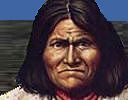 |
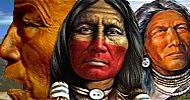 |
|
|
|
||
| N'de, Dinė, Tinde, Inde or "The People" |
| |
Geronimo goes on warpath with Mexicans |
Artifact Replicas|Jewelry|Clothing|Figurines|On Sale|New ProductsGeronimo goes on warpath with MexicansGeronimo continues to seek revenge on the Mexicans as told in his autobiography. Apache indian history. Source: As told by Geronimo, Public Domain Documents All the other Apaches were satisfied after the battle of Kaskiyeh, but I still desired more revenge. For several months we were busy with the chase and other peaceful pursuits. Finally I succeeded in persuading two other warriors, Ah-koch-ne and Ko-deh-ne, to go with me to invade the Mexican country. We left our families with the tribe and went on the war path. We were on foot and carried three days' rations. We entered Mexico on the north line of Sonora and followed the Sierra de Antunez Mountains to the south end of the range. Here we decided to attack a small village. (I do not know the name of this village.) At daylight we approached from the mountains. Five horses were hitched outside. We advanced cautiously, but just before we reached the horses the Mexicans opened fire from the houses. My two companions were killed. Mexicans swarmed on every side; some were mounted; some were on foot, and all seemed to be armed. Three times that day I was surrounded, but I kept fighting, dodging, and hiding. Several times during the day while in concealment I had a chance to take deliberate aim at some Mexican, who, gun in hand, was looking for me. I do not think I missed my aim either time. With the gathering darkness I found more time to retreat toward Arizona. But the Mexicans did not quit the chase. Several times the next day mounted Mexicans tried to head me off; many times they fired on me, but I had no more arrows; so I depended upon running and hiding, although I was very tired, I had not eaten since the chase began, nor had I dared to stop for rest. The second night I got clear of my pursuers, but I never slackened my pace until I reached our home in Arizona. I came into our camp without booty, without my companions, exhausted, but not discouraged. The wives and children of my two dead companions were cared for by their people. Some of the Apaches blamed me for the evil result of the expedition, but I said nothing. Having failed, it was only proper that I should remain silent. But my feelings toward the Mexicans did not change--I still hated them and longed for revenge. I never ceased to plan for their punishment, but it was hard to get the other warriors to listen to my proposed raids. In a few months after this last adventure I persuaded two other warriors to join me in raiding the Mexican frontier. On our former raid we had gone through the Nedni Apaches' range into Sonora. This time we went through the country of the Cho-kon-en and entered the Sierra Madre Mountains. We traveled south, secured more rations, and prepared to begin our raids. We had selected a village near the mountains which we intended to attack at daylight. While asleep that night Mexican scouts discovered our camp and fired on us, killing one warrior. In the morning we observed a company of Mexican troops coming from the south. They were mounted and carried supplies for a long journey. We followed their trail until we were sure that they were headed for our range in Arizona; then we hurried past them and in three days reached our own settlement. We arrived at noon, and that afternoon, about three o'clock, these Mexican troops attacked our settlement. Their first volley killed three small boys. Many of the warriors of our tribe were away from home, but the few of us who were in camp were able to drive the troops out of the mountains before night. We killed eight Mexicans and lost five--two warriors and three boys. The Mexicans rode due south in full retreat. Four warriors were detailed to follow them, and in three days these trailers returned, saying that the Mexican cavalry had left Arizona, going southward. We were quite sure they would not return soon. Soon after this (in the summer of 1860) I was again able to take the war path against the Mexicans, this time with twenty-five warriors. We followed the trail of the Mexican troops last mentioned and entered the Sierra de Sahuaripa Mountains. The second day in these mountains our scouts discovered mounted Mexican troops. There was only one company of cavalry in this command, and I thought that by properly surprising them we could defeat them. We ambushed the trail over which they were to come. This was at a place where the whole company must pass through a mountain defile. We reserved fire until all of the troops had passed through; then the signal was given. The Mexican troopers, seemingly without a word of command, dismounted, and placing their horses on the outside of the company, for breastworks, made a good fight against us. I saw that we could not dislodge them without using all our ammunition, so I led a charge. The warriors suddenly pressed in from all sides and we fought hand to hand. During this encounter I raised my spear to kill a Mexican soldier just as he leveled his gun at me; I was advancing rapidly, and my foot slipping in a pool of blood, I fell under the Mexican trooper. He struck me over the head with the butt of his gun, knocking me senseless. Just at that instant a warrior who followed in my footsteps killed the Mexican with a spear. In a few minutes not a Mexican soldier was left alive. When the Apache war-cry had died away, and their enemies had been scalped, they began to care for their dead and wounded. I was found lying unconscious where I had fallen. They bathed my head in cold water and restored me to consciousness. Then they bound up my wound and the next morning, although weak from loss of blood and suffering from a severe headache, I was able to march on the return to Arizona. I did not fully recover for months, and I still wear the scar given me by that musketeer. In this fight we had lost so heavily that there really was no glory in our victory, and we returned to Arizona. No one seemed to want to go on the war path again that year. In the summer (1861) with twelve warriors I again went into Mexico. We entered Chihuahua and followed south on the east side of the Sierra Madre Mountains four days' journey; then crossed over to the Sierra de Sahuaripa range, not far east of Casa Grande. Here we rested one day, and sent out scouts to reconnoiter. They reported pack trains camped five miles west of us. The next morning just at daybreak, as these drivers were starting with their mule pack train, we attacked them. They rode away for their lives, leaving us the booty. The mules were loaded with provisions, most of which we took home. Two mules were loaded with side-meat or bacon; this we threw away. We started to take these pack trains home, going northward through Sonora, but when near Casita, Mexican troops overtook us. It was at daybreak and we were just finishing our breakfast. We had no idea that we had been pursued or that our enemies were near until they opened fire. At the first volley a bullet struck me a glancing lick just at the lower corner of the left eye and I fell unconscious. All the other Indians fled to cover. The Mexicans, thinking me dead, started in pursuit of the fleeing Indians. In a few moments I regained consciousness and had started at full speed for the woods when another company coming up opened fire on me. Then the soldiers who had been chasing the other Indians turned, and I stood between two hostile companies, but I did not stand long. Bullets whistled in every direction and at close range to me. One inflicted a slight flesh wound on my side, but I kept running, dodging, and fighting, until I got clear of my pursuers. I climbed up a steep canon, where the cavalry could not follow. The troopers saw me, but did not dismount and try to follow. I think they were wise not to come on. It had been understood that in case of surprise with this booty, our place of rendezvous should be the Santa Bita Mountains in Arizona. We did not reassemble in Mexico, but traveled separately and in three days we were encamped in our place of rendezvous. From this place we returned home empty-handed. We had not even a partial victory to report. I again returned wounded, but I was not yet discouraged. Again I was blamed by our people, and again I had no reply. After our return many of the warriors had gone on a hunt and some of them had gone north to trade for blankets from the Navajo Indians. I remained at home trying to get my wounds healed. One morning just at daybreak, when the women were lighting the camp fires to prepare breakfast, three companies of Mexican troops who had surrounded our settlement in the night opened fire. There was no time for fighting. Men, women and children fled for their lives. Many women and children and a few warriors were killed, and four women were captured. My left eye was still swollen shut, but with the other I saw well enough to hit one of the officers with an arrow, and then make good my escape among the rocks. The troopers burned our tepees and took our arms, provisions, ponies, and blankets. Winter was at hand. There were not more than twenty warriors in camp at this time, and only a few of us had secured weapons during the excitement of the attack. A few warriors followed the trail of the troops as they went back to Mexico with their booty, but were unable to offer battle. It was a long, long time before we were again able to go on the war path against the Mexicans. The four women who were captured at this time by the Mexicans were taken into Sonora, Mexico, where they were compelled to work for the Mexicans. After some years they escaped to the mountains and started to find our tribe. They had knives which they had stolen from the Mexicans but they had no other weapons. They had no blankets; so at night they would make a little tepee by cutting brush with their knives, and setting them up for the walls. The top was covered over with brush. In this temporary tepee they would all sleep. One night when their camp fire was low they heard growling just outside the tepee. Francisco, the youngest woman of the party (about seventeen years of age), started to build up the fire, when a mountain lion crashed through the tepee and attacked her. The suddenness of the attack made her drop her knife, but she fought as best she could with her hand. She was no match for the lion, however; her left shoulder was crushed and partly torn away. The lion kept trying to catch her by the throat; this she prevented with her hands for a long time. He dragged her for about 300 yards, then she found her strength was failing her from loss of blood, and she called to the other women for help. The lion had been dragging her by one foot, and she had been catching hold of his legs, and of the rocks and underbrush, to delay him. Finally he stopped and stood over her. She again called her companions and they attacked him with their knives and killed him. Then they dressed her wounds and nursed her in the mountains for about a month. When she was again able to walk they resumed their journey and reached our tribe in safety. This woman (Francisco) was held as a prisoner of war with the other Apaches and died at the Fort Sill Reservation in 1892. Her face was always disfigured with those scars and she never regained perfect use of her hands. The three older women died before we became prisoners of war. Many women and children were carried away at different times by Mexicans. Not many of them ever returned, and those who did underwent many hardships in order to be again united with their people. Those who did not escape were slaves to the Mexicans, or perhaps even more degraded. When warriors were captured by the Mexicans they were kept in chains. Four warriors who were captured once at a place north of Casa Grande, called by the Indians Honas, were kept in chains for a year and a half, when they were exchanged for Mexicans whom we had captured. We never chained prisoners or kept them in confinement, but they seldom got away. Mexican men when captured were compelled to cut wood and herd horses. Mexican women and children were treated as our own people.
|
What's New in the Gallery Store: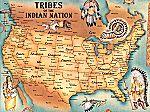 Native American Tribes by States Poster 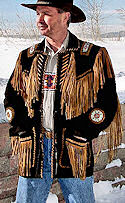 25 new fringed leather jackets 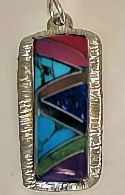 Zuni Style inlaid stone jewelry More New Products |
|||||||||||||||||||||||||||||||||||||||||||||||||||||||||||||
Apache chastity and marriage Apache customs regarding courtship, marriage and divorce. Wives and burial place of Geronimo A detailed list of all the wives of Gernonimo and his burial place. Why do we yell "Geronimo"? Learn the legend behind this phrase. Apache tribal amusements, manners, and customs As explained by Geronimo in the telling of his life story.
| |
| Back to Top |Shipping & Return Policies |Customer Testimonials |Site Map |Affiliate Program |Privacy Policy |Contact Us | Submissions |